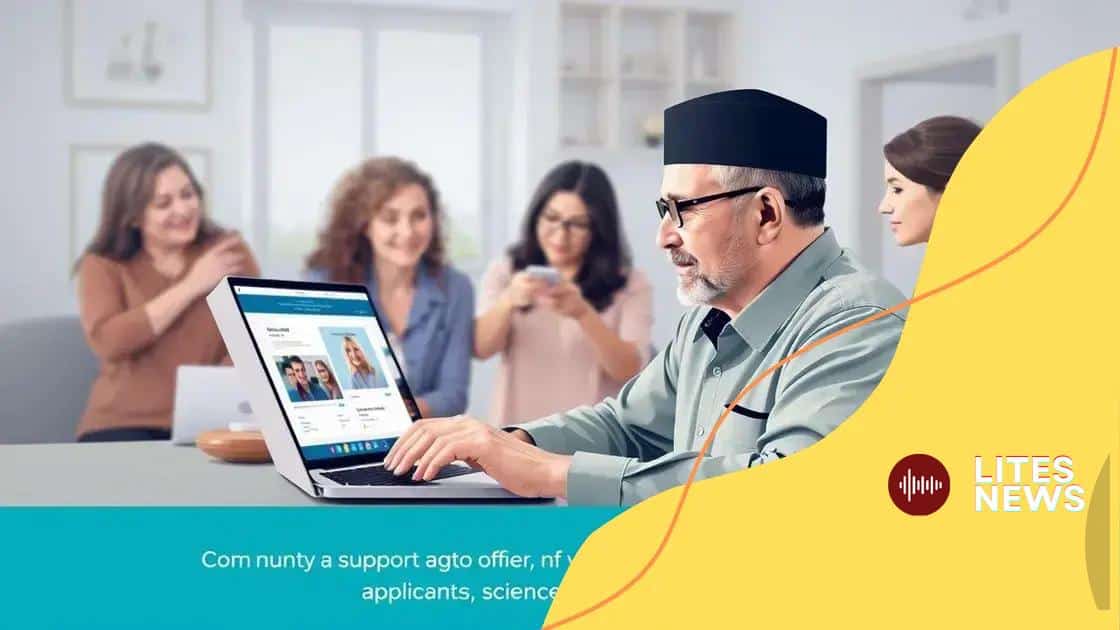Veterans’ benefits modernization: what you need to know

Veterans’ benefits modernization improves access to resources, enhances support services, and streamlines processes, empowering veterans and their families to effectively navigate their entitlements.
Veterans’ benefits modernization is a hot topic these days, with changes that could greatly impact veterans everywhere. Have you wondered how these updates affect your benefits? Let’s dive into it.
Understanding veterans’ benefits modernization
Understanding veterans’ benefits modernization is essential for navigating the support available to those who have served. This process involves updating and improving the benefits system to better meet the needs of today’s veterans.
Recently, several changes have been announced, aiming to streamline processes and enhance accessibility. Veterans’ benefits modernization focuses on making it easier for veterans to access their entitled benefits, ensuring they receive the support they need.
Key Components
This modernization includes important aspects such as:
- Improved online services for applications and inquiries.
- Increased support for mental health resources.
- Better communication channels between the VA and veterans.
- Enhanced educational assistance programs.
By focusing on technology and user experience, the government aims to reduce wait times and simplify the process for veterans. These updates provide a fresh look at how benefits are delivered, expanding the potential for using digital platforms to reach more people.
For instance, veterans can now manage their benefits online, making updates and seeking information without having to visit a local office. This shift not only saves time but also encourages more veterans to engage with the resources available to them.
Impacts on Accessibility
Accessibility is a cornerstone of the veterans’ benefits modernization initiative. The goal is to create a system where every veteran can easily understand and utilize their benefits. With comprehensive guides and user-friendly websites, the aim is to clear up any confusion.
The modernization also seeks to address barriers that some veterans have faced in the past. It’s crucial that all veterans, regardless of their location or knowledge of technology, can navigate the system. By focusing on inclusivity, the initiative is shaping a benefits system that truly serves all.
Engagement from veterans is vital to the ongoing improvement of the system. As feedback is collected, the VA can adjust strategies and ensure continuous modernization that reflects the needs of the community.
Key changes in veterans’ benefits
Key changes in veterans’ benefits are crucial for ensuring that veterans receive the support they deserve. Recent updates to the benefits system focus on making processes more efficient and accessible.
These changes aim to address both past shortcomings and modern needs. One significant update is the introduction of faster processing times for claims. This means veterans will no longer have to wait long periods to receive their benefits.
Significant Updates
Some of the significant changes include:
- Streamlined online application processes.
- Elimination of redundant paperwork.
- Enhanced support for mental health initiatives.
- Expanded educational benefits for veterans and their families.
Additionally, the modernization effort focuses on improving communication between the Department of Veterans Affairs (VA) and veterans. This includes better notification systems that keep veterans informed about their claims and services.
These changes not only increase accessibility but also empower veterans to take charge of their benefits. For instance, by using online tools, veterans can track their applications and access resources easily.
Improved Accessibility and Services
Accessibility is at the forefront of these updates. It’s essential that all veterans can benefit from these changes without barriers. With more user-friendly interfaces and information available online, veterans can find answers quickly.
This modernization also includes training for VA staff to ensure they are prepared to assist veterans effectively. Proper training enhances the quality of service and helps to build trust between veterans and those providing their benefits.
Engaging with veterans’ communities provides vital feedback for continued improvement. Each voice matters in shaping a system that truly meets their needs.
How to navigate the new system

Navigating the new system of veterans’ benefits modernization can seem daunting at first. However, understanding how to access your benefits and resources is essential for every veteran today.
One of the first steps you should take is to familiarize yourself with the online portal. This platform is designed to simplify your experience by providing all necessary information in one place. The site is user-friendly, allowing you to submit claims, check your status, and access vital resources.
Steps to Accessing Benefits
Here are some key steps to help you navigate the new system:
- Create a personal account on the VA website.
- Gather all necessary documents, including your DD214 and medical records.
- Use the online application for benefits, making sure to fill it out completely.
- Track your application status regularly through your account.
Once you have your account set up, it’s important to explore the various services available to you. The site offers a wealth of information on health care, educational benefits, and housing assistance. Understanding these options is crucial for making informed decisions about your benefits.
If you encounter any issues, don’t hesitate to reach out for help. The VA has several contact methods, including phone support and live chat options on the website. Connecting with a knowledgeable representative can clarify doubts and guide you through the process.
Utilizing Available Resources
Another aspect of navigating the new system is to utilize the resources provided by veteran organizations. Numerous groups exist to support veterans and can offer assistance with applications and benefits questions.
These organizations can help you understand your entitlements and provide workshops to improve your knowledge about the benefits system. Participating in community events and outreach programs is a great way to stay informed about updates and new services.
Remember, being proactive in learning about your benefits is vital. Engage with the information available online and through community resources. This approach will empower you in making the most of the veterans’ benefits modernization updates.
Impacts on veterans’ families
The impacts of veterans’ benefits modernization extend beyond the veterans themselves; families of veterans also feel significant changes. As the system improves, these families gain better access to resources and support.
One major area of impact is educational benefits. The modernization allows veterans’ children and spouses to access scholarships and grants more easily. This means families can plan for a brighter future without the financial burden that often comes with higher education.
Support Services for Families
Veterans’ families can also benefit from enhanced support services. Some key offerings include:
- Access to counseling and mental health resources.
- Workshops on financial literacy and benefit navigation.
- Support groups to connect with other families.
- Programs that provide respite care for caregivers.
These resources are crucial in helping families cope with the unique challenges they face. High levels of stress can occur when a family member is a veteran, especially if there are mental health issues involved.
Additionally, as families learn to navigate the new benefits system, they become empowered. They can make informed decisions about their needs. This improvement promotes healthier family dynamics and allows for better planning in various aspects of life.
Community Engagement
Community support is vital for veterans’ families. Organizations that focus on helping veterans often extend their services to families as well. Being involved in community events can help families find connections and resources they might not know about otherwise.
For instance, local veteran organizations often host events that include workshops and family days, allowing families to engage with one another and share experiences. This interaction promotes a sense of belonging and understanding within the veteran community.
As the modernization unfolds, it is essential for veterans’ families to stay informed and actively participate in the available resources. By doing so, they can enhance their quality of life and effectively support their veteran family members.
Future of veterans’ benefits
The future of veterans’ benefits is looking promising as modernization efforts continue to evolve. These changes aim to create a more responsive and efficient system that meets the needs of veterans and their families.
One aspect of the future involves utilizing technology more effectively. With advances in digital tools, veterans can access their benefits through user-friendly online platforms. This shift aims to reduce wait times and provide timely support.
Increasing Accessibility
Future improvements also focus on making benefits easier to access. Some anticipated changes include:
- Enhanced mobile applications for managing benefits.
- Increased resources for mental health support.
- More informed decision-making tools for veterans.
- Expansion of programs related to job training and education.
These updates will provide veterans with greater control over their benefits. By focusing on accessibility, the system intends to empower veterans to take full advantage of the resources available to them.
Moreover, more outreach initiatives are planned to ensure that all veterans, especially those in rural areas, are aware of and can access their benefits. This commitment shows that enhancing awareness is a priority for the future.
Collaboration and Feedback
The future of veterans’ benefits will heavily rely on collaboration between the Department of Veterans Affairs (VA) and the veteran community. By gathering feedback from veterans, the VA can refine programs and services to better serve their needs.
Involvement in community forums and support groups gives veterans a voice in shaping the benefits system. This participatory approach ensures that the system remains relevant and responsive to changing needs.
Overall, as modernization continues, the commitment to supporting veterans will only strengthen. Staying informed about these changes will enable veterans to leverage the full potential of their benefits in the years to come.
The modernization of veterans’ benefits is a significant step toward improving the quality of life for veterans and their families. As changes continue to unfold, it’s clear that accessibility, support, and community involvement are at the forefront. By utilizing new technologies and resources, veterans can navigate their benefits with greater ease. Moreover, the participation of veterans in shaping these programs helps ensure that their voices are heard. This commitment to enhancement signals a brighter future for those who have served our country.
FAQ – Frequently Asked Questions About Veterans’ Benefits Modernization
What are the key benefits of veterans’ benefits modernization?
The key benefits include improved access to resources, faster processing times for claims, and enhanced support services for veterans and their families.
How can veterans access their benefits more easily?
Veterans can access their benefits through user-friendly online platforms, which allow them to apply, track claims, and access vital information conveniently.
What role do community organizations play in supporting veterans?
Community organizations provide valuable resources, support services, and workshops, helping veterans navigate the benefits system and connect with others.
How can veterans ensure their voices are heard in the benefits process?
Veterans can participate in community forums and provide feedback to the Department of Veterans Affairs, ensuring their needs are addressed in the modernization efforts.





